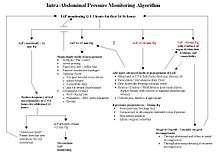Abdominal compartment syndrome
| Abdominal compartment syndrome | |
|---|---|
| Classification and external resources | |
| Specialty | emergency medicine |
| ICD-10 |
M79.A3 (non-traumatic); T79.A3XA (traumatic) |
| ICD-9-CM |
729.73 (non-traumatic); 958.93 (traumatic) |
| eMedicine | article/829008 |
Abdominal compartment syndrome occurs when the abdomen becomes subject to increased pressure. Specific cause of abdominal compartment syndrome is not known, although some causes can be sepsis and severe abdominal trauma. Increasing pressure reduces blood flow to abdominal organs and impairs pulmonary, cardiovascular, renal, and gastro-intestinal (GI) function, causing multiple organ dysfunction syndrome and death.[1]
Pathophysiology
Abdominal compartment syndrome occurs when tissue fluid within the peritoneal and retroperitoneal space (either edema, retroperitoneal blood or free fluid in the abdomen) accumulates in such large volumes that the abdominal wall compliance threshold is crossed and the abdomen can no longer stretch. Once the abdominal wall can no longer expand, any further fluid leaking into the tissue results in fairly rapid rises in the pressure within the closed space. Initially this increase in pressure does not cause organ failure but does prevent organs from working properly - this is called intra-abdominal hypertension and is defined as a pressure over 12 mm Hg in adults. However, if the pressure continues to rise over 20 mm Hg and organs begin to fail, the syndrome has now progressed to the end stage of the highly fatal process termed abdominal compartment syndrome. These pressure measurements are relative. Small children get into trouble and develop compartment syndromes at much lower pressures while young previously healthy athletic individuals may tolerate an abdominal pressure of 20 mm Hg very well. The underlying cause of the disease process is capillary permeability caused by the systemic inflammatory response syndrome (SIRS) that occurs in every critically ill patient. SIRS leads to leakage of fluid out of the capillary beds into the interstitial space in the entire body with a profound amount of this fluid leaking into the gut wall, mesentery and retroperitoneal tissue. (For a much more extensive discussion on the topic and physiology visit the Wikipedia section discussing intra-abdominal hypertension.)
- Peritoneal tissue edema secondary to diffuse peritonitis, abdominal trauma
- Fluid therapy due to massive volume resuscitation
- Retroperitoneal hematoma secondary to trauma and aortic rupture
- Peritoneal trauma secondary to emergency abdominal operations
- Reperfusion injury following bowel ischemia due to any cause
- Retroperitoneal and mesenteric inflammatory edema secondary to acute pancreatitis
- Ileus and bowel obstruction
- Intraabdominal masses of any etiology
- Abdominal packing for control of bleeding
- Closure of the abdomen under undue tension
- Ascites / intraabdominal fluid accumulation[2]
- Acute pancreatitis with abscesses formation
Abdominal compartment syndrome follows a destructive pathway similar to compartment syndrome of the extremities. When increased compression occurs in such a hollow space, organs will begin to collapse under the pressure. As the pressure increases and reaches a point where the abdomen can no longer be distended it starts to affect the cardiovascular and pulmonary systems. When abdominal compartment syndrome reaches this point without surgery and help of a silo the patient will most likely die. There is a high mortality rate associated with abdominal compartment syndrome.[1][3]
Treatment

Operative decompression
Surgical decompression can be achieved by opening the abdominal wall and abdominal fascia anterior in order to physically create more space for the abdominal viscera. Once opened, the fascia can be bridged for support and to prevent loss of domain by a variety of medical devices (Bogota bag, artificial bur, and vacuum devices using negative pressure wound therapy [4]).
References
- 1 2 http://findarticles.com/p/articles/mi_qa3689/is_200401/ai_n9346109/[][]
- ↑ Wittmann, Dietmar H; Iskander, Gaby A (2000). "The Compartment Syndrome of the Abdominal Cavity: A State of the Art Review". Journal of Intensive Care Medicine. 15 (4): 201–20. doi:10.1046/j.1525-1489.2000.00201.x.
- ↑ Abdominal Compartment Syndrome at eMedicine
- ↑ Fitzgerald, James EF; Gupta, Shradha; Masterson, Sarah; Sigurdsson, Helgi H (2013). "Laparostomy management using the ABThera™ open abdomen negative pressure therapy system in a grade IV open abdomen secondary to acute pancreatitis". International Wound Journal. 10 (2): 138–44. doi:10.1111/j.1742-481X.2012.00953.x. PMID 22487377.